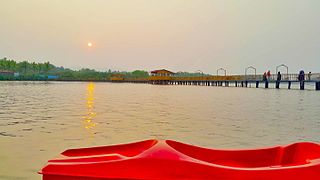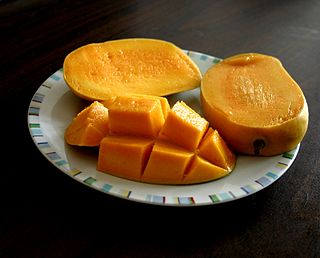Related Research Articles

Kannur is one of the 14 districts along the west coast in the state of Kerala, India. The city of Kannur is the district headquarters and gives the district its name. The old name, Cannanore, is the anglicized form of the Malayalam name "Kannur". Kannur district is bounded by Kasaragod District to the north, Kozhikode district to the south, Mahé district to the southwest and Wayanad District to the southeast. To the east, the district is bounded by the Western Ghats, which forms the border with the state of Karnataka. The Arabian Sea lies to the west. Paithalmala is the highest point in Kannur District (1,372m). Enclosed within the southern part of the district is the Mahé district of the Union Territory of Puducherry. The district was established in 1957.
Kuttiattoor is a census town in Taliparamba taluk of Kannur district in the Indian state of Kerala. Kuttiattoor is located 26 km (16 mi) north east of District headquarters Kannur and 6.5 km (4.0 mi) south east of Mayyil.
Alibag taluka is a taluka in Raigad district of the Indian state of Maharashtra.
Sirarakhong also called as Kampha is a village located west of Ukhrul in Ukhrul district, Manipur state, India. As per 2011 census, the village has a total of 202 households with 1243 persons of which 620 are male while 623 are female. Of the total population, 10.86% are in the age group of 0–6 years. The average sex ratio of the village is 1015 female per 1000 male which is higher than the state's average of 930. The literacy rate of the village is 95.22%.

The Nanjangud banana is a variety of banana from Nanjangud, Mysore district, Karnataka. This fruit has a unique taste and aroma, and is locally popular. It has been given Geographical Indication Tag Number 29, which helps protect and promote the unique identity of the banana.

The 'Gir Kesar' mango, also called Kesar, is a mango cultivar grown in the foothills of Girnar in Gujarat, western India. The mango is known for its bright orange colored pulp and was given the geographical indication status in 2011. The biggest market of Gir Kesar is in Talala Gir known as a Mango Market Yard.
The 'Kari Ishad' mango, is a mango cultivar primarily grown in Ankola and Karwar talukas of Uttara Kannada district, Karnataka, India.
The 'Mankurad' mango, is a mango cultivar primarily grown in the coastal state of Goa, India. It is also cultivated in Vengurla and Malvan talukas of Maharashtra along within Uttara Kannada district of Karnataka. Malcorado, Mancurad, Mankur, Kurad, Corado are variations of the same name. Mankurad varieties include the Cardozo Mancurad, Costa Mancurad, Gawas Mancurad, and Amaral Mancurad.

The Khola chilli is a variety of chilli mainly grown in the Indian state of Goa.

The Harmal chilli is a variety of chilli mainly grown in the Indian state of Goa.
The 'Appemidi' mango, is a mango cultivar primarily grown in Malenadu region of Karnataka, India. Appe midi is the variation of the same name. Appemidi varieties include Ananta Bhattana, Kanchappa, and Karnakundala.
The 'Malihabadi Dusseheri' mango, is a mango cultivar primarily grown in the town of Malihabad, Lucknow district of Uttar Pradesh, India. The Malihabadi Dusseheri mangoes are unique from the Dussehri variety grown elsewhere in India.
The 'Marathwada Kesar mango', is a mango cultivar primarily grown in Marathwada region of Maharashtra, India. Districts where they are primarily grown are Chhatrapati Sambhaji Nagar, Jalna, Beed and Latur.
The 'Rataul' mango, is a mango cultivar primarily grown in Rataul of Baghpat district, Uttar Pradesh, India.
The 'Malda Fazli' mango, is a mango cultivar primarily grown in Malda district, West Bengal, India. It is also known as 'Fazli Babu'.

The Bhiwapur chilli is a variety of chilli mainly grown in Nagpur district, of the Indian state of Maharashtra.

The Edayur chilli is a variety of chilli mainly grown in the Indian state of Kerala. The Edayur chilli is a local cultivar primarily grown in specific regions of Kerala's Malappuram district. Specifically, it is cultivated in the panchayaths of Edayur, Athavanad, Marakkara, Irimbiliyam, Kalpakanchery, and Valanchery within the Valanchery block, as well as Moorkanad and Kuruva panchayaths within the Angadippuram block.

The Banaras Lal Bharwamirch (Red Pickle Chilli) is a variety of chilli grown in the Indian state of Uttar Pradesh. It is mainly cultivated in Varanasi, Azamgarh, Jaunpur, Ghazipur & Ballia districts of Uttar Pradesh.
The Central Travancore jaggery is a variety of jaggery made from fresh sugarcane juice in the Indian state of Kerala. It is an agri-product manufactured from sugarcane which is a common and widely cultivated crop in Kottayam and Pathanamthitta Districts and Chengannur taluk in Alappuzha District. The riverbanks and nearby places of Pamba, Manimala, Achenkovil and Meenachil rivers are primarily used for sugarcane cultivation in the region.
The Marayoor jaggery is a variety of jaggery made from fresh sugarcane juice in the Indian state of Kerala. It is an agri-product manufactured from sugarcane which is a common and widely cultivated crop in Marayoor and Kanthalloor Grama panchayaths of Devikulam taluk, Idukki district grown particularly by the farmers of Muthuva tribe.
References
- ↑ Nagarajan, Saraswathy (2 June 2022). "The sweet taste of brand Kuttiattoor". The Hindu. Retrieved 6 October 2024.
- ↑ "Will a mango by any other name taste as sweet?". BusinessLine. 15 July 2015. Retrieved 6 October 2024.
- ↑ John, Haritha (7 July 2015). "The curious fight over "upper-caste" mangoes in a Kerala village". The News Minute. Retrieved 6 October 2024.
- ↑ Minute, The News (7 July 2015). "Fight in Kerala Village Over 'Caste' Mangoes". TheQuint. Retrieved 6 October 2024.
- ↑ "GI tag for Kerala's Kuttiattoor mango & Edayur chilli". The Times of India. 10 October 2021. Retrieved 6 October 2024.
- ↑ "Kuttiattoor mangoes: Fruits with a royal lineage, ripened with hay and 'kaanjiram' leaves". Onmanorama. Retrieved 6 October 2024.
- ↑ Sen, Piyali (2 June 2023). "10 Indian Mangoes With GI Tags". Outlook Traveller. Retrieved 6 October 2024.
- ↑ "This Kerala Mango Variety First From The State To Get GI Tag". News18. 31 May 2024. Retrieved 6 October 2024.
- ↑ "Geographical Indications Intellectual Property India". Official website of Intellectual Property India. Retrieved 6 October 2024.
